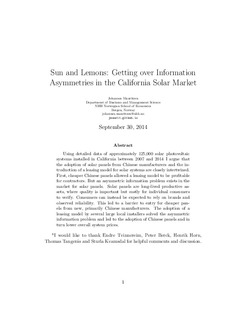Sun and lemons : getting over information asymmetries in the California Solar Market
Working paper
Permanent lenke
http://hdl.handle.net/11250/223718Utgivelsesdato
2014-09Metadata
Vis full innførselSamlinger
- Discussion papers (FOR) [566]
Sammendrag
Using detailed data of approximately 125,000 solar photovoltaic
systems installed in California between 2007 and 2014 I argue that
the adoption of solar panels from Chinese manufacturers and the in-
troduction of a leasing model for solar systems are closely intertwined.
First, cheaper Chinese panels allowed a leasing model to be profitable
for contractors. But an asymmetric information problem exists in the
market for solar panels. Solar panels are long-lived productive as-
sets, where quality is important but costly for individual consumers
to verify. Consumers can instead be expected to rely on brands and
observed reliability. This led to a barrier to entry for cheaper pan-
els from new, primarily Chinese manufacturers. The adoption of a
leasing model by several large local installers solved the asymmetric
information problem and led to the adoption of Chinese panels and in
turn lower overall system prices.
